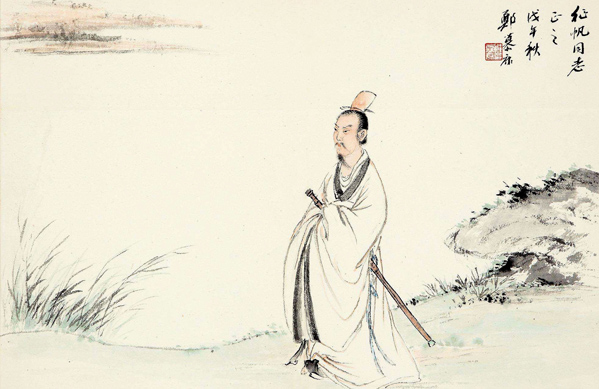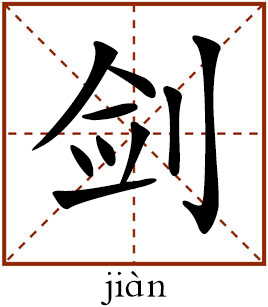Swords symbolize justice, aspiration

Roaming by the river, the image of Qu Yuan (c.340-c.278 BCE) carrying a sword is a typical image of a frustrated official–scholar who was denied his opportunity to benefit the society.

More than simply ornaments, swords in Chinese culture are symbols of one’s aspiration to contribute to society and can represent the sorrow of being unable to do so when one is not provided with fair opportunities.
Swords are considered “gentlemen” among weapons in Chinese culture. Transcending its original existence as cold steel, swords symbolize the pursuit of one’s ideals and a sense of righteousness. They are symbols of bravery, loyalty, righteousness, wisdom, propriety and credit.
History, culture
Jian, which means swords, or baojian, which means “treasured swords,” as first mentioned in Zuo’s Commentary on the Spring and Autumn Annals, are double-edged weapons. Chinese swords are usually three-chi long, which equals exactly one meter. Hence, another name for swords in Chinese is sanchi, which means Three Chi.
The history of Chinese swords dates back to the legendary age of the Yellow Emperor. According to the Records of Famous Swords by Li Chengxun (1473-1531), the Yellow Emperor forged a sword with copper mined from the Shou Mountain and inscribed words on it. The Guanzi, by Guan Zhong (c.723-c.645 BCE), included the line: “[Ten years after the Yellow Emperor issued a law forbidding unlicensed mining,] torrents gushed out of Mount Gelu and afterwards, metal mines were uncovered in that area, Chi You took them over and started making weapons and armor such as swords, corselets, spears and halberds.”
Chi You was the leader of the Dongyi tribes and was believed to be the God of Weapons and War in ancient Chinese culture. The legendary wars between Chi You and the Yellow Emperor shaped Chinese civilization. This mythology provides us a glimpse of the role of swords in early Chinese history.
The swords in the Shang Dynasty were mostly shaped like willow leaves and made of bronze. When chariots played a significant role in warfare, swords were mostly used in central China as a complement to long weapons such as spears and dagger-axes. In the later part of the Spring and Autumn Period when fighting on foot became popular, sword manufacturing also became more detailed.
The Wu and Yue areas in present-day Zhejiang and Jiangsu provinces in this period of time were famous for the swords they produced. For example, preserved in Hubei Provincial Musuem, the most well-known sword, the Sword of Goujian, was produced in this area. Belonging to the King Goujian (c.520-c.465 BCE) of the Yue Kingdom, the sword is 55.7cm long and 4.6 cm wide. The blade of the sword is ribbed and decorated with a black diamond pattern. Close to the hilt are the bird seal inscriptions. The front side of the blade is set with blue glaze while the reverse side is set with turquoise.
Many famous swordsmiths and sword appraisers emerged as the sword-manufacturing industry prospered in this period of time. Legends about Ouye Zi, the founder of sword-manufacturing industry and the famous blacksmith couple Gan Jiang and Mo Ye, as well as some legendary swords of the era, are still frequently referred to in Chinese martial arts literature.
Justice, aspirations
Swords played a special role in Chinese spiritual history. Gradually spreading from the aristocratic class to popular society, they are frequently used as cultural symbols by all walks of life.
Swords were common decorations of the aristocrats, serving as a symbol of their noble social status. In the Tao Te Ching, Lao Tzu described this by saying “[Their] robes are embroidered silk and they bear sharp swords.”
For the literati, the swords were “sharp weapons” used to express their aspirations and feelings. The long and straight traits of the swords were the embodiment of their learned and refined personality. The fortitude and seriousness of a sword was an expression of their perseverance in the pursuit of worldly achievement and maintaining a noble spiritual world. The ridge of a sword is straight, serving as the symmetrical axis of the two edges. It is a symbol of justice and impartiality.
For example, even when exiled from his mother kingdom, in a verse in the Chu style, Qu Yuan still described the image of himself as “The sheath of the sword I wear is motley and long; My cloud-touching hat bears a grandeur untold.”
Using the image of swords in many of his poems, Li Bai was another example of the influence of swords in Chinese culture. Enthusiastic about practicing fencing, he “practiced fencing since the age of 15.” Typically, Li used swords to express his aspiration to contribute to the nation. For example, his verse “The Emperor swept the world of his foes, Looking around like a tiger, he rose. He broke the floating clouds while wielding swords, Westwards to pay their homage, came all lords” describes his aspiration by quoting the story of the Emperor Qin Shihuang of the Qin Dynasty who united China after centuries of chaos.
However, when the poets’ aspiration to benefit his nation was provided with fair opportunities, swords became a symbol of sorrow and anger. For example, Bao Zhao (414-466) once wrote “In the face of the food on the desk, I lose my appetite; Drawing the sword and striking it at the pillar, I deeply sighed.”
The An Lushan and Shi Siming Rebellion (755-763) heavily shook the Tang Dynasty. Li Bai was not offered an opportunity to serve his nation during this calamity. Sorrowed by this, he wrote “The fine sword hanged on the wall; roaring like a dragon as it always does. Meant to kill the rhinoceros and elephants; it is now covered with moss and rust.”
Another story about this was recorded in the Records of the Grand Historian by Sima Qian. Harboring thousands of protégés, Lord Mengchang, one of the Four Gentlemen in the Warring States Period, did not give much attention to the new comer Feng Xuan. Feng was poor and owned nothing but a sword with a plaited reed round its hilt. He beat his sword and sang, “Let’s go back home, long sword! Here I have no fish to eat!” Hearing this, the lord moved him to a better shelter so that he could have fish for meals. Again and again, Feng beat his sword and sang songs, complaining about having neither carriage nor house of his own. Every time, the lord satisfied his demand.
One year later, the lord sent Feng to collect debts in Xue County. Feng exempted those who could not pay the debt, lying about the orders he had been given by the lord. A year later, when Lord Mengchang was libeled and unfairly dismissed by the King, the people from Xue County traveled 50 kilometers outside the county to welcome him. Despite of the happy ending, the phrase “Feng’s singing to his long sword” became a frequently used story when one feels that he is not respected in the way that he deserves.
King’s sword
Weapons as swords were never considered the best means of tackling conflicts. Zi Lu, a prominent student of Confucius once asked “Did the gentlemen in ancient times protect themselves with swords?” Confucius said “Ancient gentlemen took loyalty as the key quality and benevolence and righteousness as his protection…He changed those who were unfriendly to him with his loyalty and provided peace to those who wanted to cross him with his benevolence and righteousness. Why do they need a sword?”
King Wen of Wei Kingdom loved to watch people fencing. A lot of casualties were caused as a result. Claiming to be good at fencing, Chuang Tzu visited King Wen and said to him “I have three swords—the sword of the king, the lord and the common people. Please allow me to explain what I mean before starting the contest.”
“The sword of the king is made with Yanxi Gorge and Shicheng Hill as its point. Mount Tai is its blade…It is wrapped with the uncivilized tribes and enriched with the four seasons, surrounded by the waters in the Bohai Sea. It governs the world with the five elements and judges the right and the wrong with punishment and virtue. It initiated its power with energy of yin and yang, maintains its power with warmth of spring and summer, and exercises its power with the force of autumn and winter. Nothing remains whatever way the sword thrusts…Once in use, it can rectify the lords and subdue all.”
“The sword of the lord is made with men of courage and intellect of its point, men of honesty as its blade, capacity and virtue as spine, loyalty and wisdom as ring and valor as handle…It obeys the laws of the round heaven and square earth as well as the will of the public and achieves stability all over…”
This tale by Chuang Tzu was considered the first martial arts fiction in Chinese history. The visible and tangible swords in Chinese culture were generally considered inferior to the invisible and intangible swords that follow the laws of the nature, the heaven, the earth or the will of the public. The Chinese character “武” means armed forces and is made up of two parts “止” which means “to stop” and “戈” which means “dagger-axe.” This indicates that the martial arts is meant to cease conflicts rather than initiating one. The intangible swords harnessed by the laws of the nature were the best and most desirable ones because, to some extent, peace only prevails when the laws of the nature dominate the operation of all things.
(edited by CHEN ALONG)
